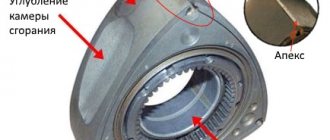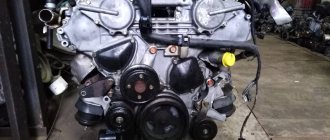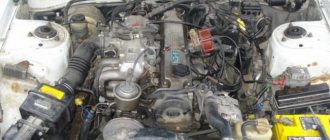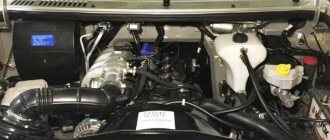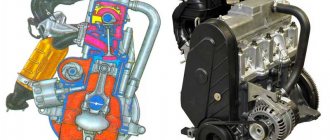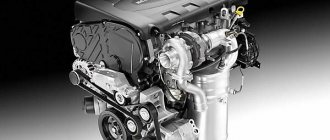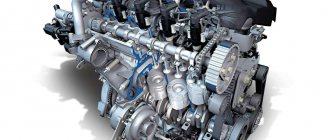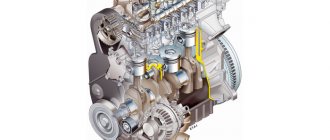Technical characteristics of RPD VAZ-415
| Options | VAZ-4132 | VAZ-415 |
| Number of sections | 2 | 2 |
| Engine chamber displacement, cc | 1,308 | 1,308 |
| Compression ratio | 9,4 | 9,4 |
| Rated power, kW (hp)/min-1 | 103(140)/6000 | 103(140)/6000 |
| Maximum torque, N*m(kgf*m)/min-1 | 186(19)/4500 | 186(19)/4500 |
| Minimum eccentric shaft rotation speed at idle, min-1 | 1000 | 900 |
| Engine weight, kg | 136 | 113 |
| Overall dimensions, mm | ||
| height | 560 | 570 |
| width | 546 | 535 |
| length | 495 | 665 |
| Minimum specific fuel consumption (according to VSKh), g/kW*h (g/hp*h) | 312.2(230) | 312.2(230) |
| Oil consumption as a % of fuel consumption | 0,7 | 0,6 |
| Engine life before the first major overhaul, thousand km | 125 | 125 |
| Purpose | VAZ-21059/21079 | VAZ-2108/2109/21099/2115/2110 |
Characteristics and application of VAZ rotary piston engines
VAZ rotary piston engines. Rare VAZ engines
VAZ began to develop the rotary piston engine (RPE) back in 1974 on the basis of the rotary piston automobile engine developed by German engineers Felix Wankel and Walter Freude (Design Bureau headed by Boris Sidorovich Pospelov). Already in 1976, based on German developments, VAZ engineers managed to assemble their own engine model - VAZ 301, whose power was 70 hp. This was just an experimental sample and installation on a car was not yet planned. Over the next five years, work was carried out to eliminate all the shortcomings and adapt the VAZ rotary piston engine to the engine compartment of the car and connect it to the transmission.
In 1978, the RPD was put “on wheels”, and in 1982, a single-section VAZ rotary piston engine, already with the VAZ 311 index, was installed on the first experimental series of cars - VAZ 21018. Unfortunately, it took five years to fine-tune the fundamentally new rotary piston engine the engine was not enough. Cars equipped with it did not undergo a sufficient number of tests, as a result of which defects were identified already in the pilot series and in almost all of them the engine had to be replaced with a conventional piston one.
There weren’t that many malfunctions in the new VAZ RPDs. The seals that could not withstand pressure and temperatures and the bearing assembly that failed under load were quickly replaced. But it was not possible to quickly eliminate the insufficient balance of the rotor-eccentric mechanism (REM), which did not arise immediately, but led to interruptions in engine operation. A solution to this problem was found in the development of a two-section rotary piston engine, temporarily abandoning the single-section RPD.
It took less than a year to qualitatively develop a two-section RPD. The VAZ 411 and VAZ 413 models of two-section rotary piston engines that performed well during tests were new, modified and performed well during tests. The VAZ 411 RPD was capable of developing a power of 120 hp, while the VAZ 413 RPD was capable of developing 140 hp. This success brings interest in new engines from the security forces of the USSR, who are asking to supply them with cars with rotary piston engines. For the needs of the Ministry of Internal Affairs and the KGB, VAZ engineers equipped the GAZ-21, GAZ-24 and GAZ 3102 cars with a rotary piston VAZ 413. Which were later nicknamed “catch-up” for their dynamic qualities. This engine has shown good service life and trouble-free operation in practice. But VAZ design engineers, after this success, did not continue to develop new rotary piston engines for cars, but directed their attention to the development of aviation RPDs.
Having achieved certain successes in the construction of aviation RPDs, only in the early 90s did the development of a VAZ rotary piston engine for a front-wheel drive vehicle begin. In 1992, VAZ managed to create a prototype - the RPD VAZ 414, which, theoretically, could be used on cars with front-wheel drive. The model was two-section and was capable of developing power of more than 130 hp, but for some reason it was not put into production immediately. It is likely that the engine was “raw”; moreover, work was needed to connect it to the transmission. So, it takes more than five years for refinement and testing. As a result, in 1997, VAZ announced the completion of development and certification of a new RPD - VAZ 415. This model was universal, ready for installation as cars with front-wheel drive, rear-wheel drive and even all-wheel drive. The power characteristics remained almost the same as those of the VAZ 414 - 135 hp. with a two-section component.
In addition, for the Ministry of Internal Affairs, the production of cars on VAZ rotary piston engines was continued. A slightly improved RPD VAZ 413 (VAZ - 4132), starting in 1991, was installed on new police “catch-up” cars - VAZ 2107 (21079) cars.
Source
VAZ 21079 Rotary piston engine
I would like to share with you historical facts of the Russian automobile industry, namely about the VAZ 21079.
Outwardly, it is no different from the rest of the VAZ 2107 family, but the engine...
In this model, AvtoVAZ designers installed an engine that was innovative in those years: Rotary piston (such an engine in the automotive industry is now used only by Mazda in its RX-8 model).
Rotary piston engine (aka Wankel engine) This engine has serious disadvantages: 1) The combustion chamber of a rotary engine is elongated, like the crescent of a young moon. Naturally, heat losses over a larger area than in a conventional cylinder lead to a high heat load on the engine and lower efficiency. In such a combustion chamber, effective mixing of the working mixture does not occur, and then - poor efficiency and environmental friendliness. 2) From the point of view of a technologist, a rotary engine is far from a gift. Unlike conventional piston engines, in which the fuel combustion process occurs alternately in different cylinders, and in between, the combustion chamber is cooled during the intake stroke by the working mixture, a rotary engine has only one combustion chamber that operates constantly. Therefore, the rotor must be resistant to temperature changes when the heated surface begins to cool the working mixture through a stroke. 3) Another problem is seals. In a piston internal combustion engine, the rings operate at the same operating angle. In a rotary engine, when the rotor slides at its angles on the surface of the stator, the seals have to work at different angles. Naturally, friction has to be reduced by injecting oil directly into the manifold. Environmental friendliness suffers even more... Well, for the record: a rotary engine simply cannot run on diesel fuel. It will not withstand the kind of loads that are typical of a diesel engine.
The VAZ-21079 engine capacity was 1.3 liters and had a power of 140 hp. Initially, in the 83s, this car was created for the needs of special services, 140 hp. with a weight of about 1000 kg, it was enough to catch up with foreign cars that have a little more power but more weight.
The service life of the engine produced by AvtoVAZ was approximately 50,000 km, then the engine was subject to major overhaul, which was carried out only at the manufacturer's plant.
Unfortunately, AvtoVAZ management did not begin to modify this engine and simply closed production.
Source
general information
For the first time in Russia, the VAZ-415 with a rotary engine appeared in 1996 on the basis of the VAZ-2109. The vehicle differed from its competitors in its increased power performance. An experimental 140 horsepower engine accelerated the car to 100 km/h in just eight seconds. At the same time, the speed threshold was about 200 km/h.
The capacity of the fuel tank is 39 liters, fuel consumption has increased noticeably. A full refueling was enough for a trip from Moscow to Smolensk and back. The fact that the car did not go into mass production is explained by its solid “appetite”, as well as its high cost. After the starting prototype, manufacturers released two more copies: versions with 150 and 250 “horses”. The increased dynamics in practical terms did not provide anything useful. The engine, boosted in all respects, became completely unusable after 40 thousand kilometers.
Rotary piston engines VAZ 301 311 411 413 414 415 425 rare VAZ engines
The VAZ 2109 with a rotary engine was at one time perceived as a joke. Allegedly, at a speed of 200 km/h, such a “nine” overtook Mercedes, but there is some truth in every joke. A rotary engine was installed on the VAZ 2109 and it was indicated that in terms of dynamic and speed qualities the car was superior to all known models of the domestic automobile industry. But why was the production of such “nines” not put into production? Let's try to find out everything related to this issue and present the advantages of a rotary engine over a conventional internal combustion engine.
RPD in the USSR and after
Rotary engine of the VAZ 2109
Let's start with the fact that in 1996, the VAZ 2109 with a rotary engine began to be produced in our country. It was a car with increased power. Under the hood, a 140-horsepower rotor engine rumbled, accelerating the beloved “nine” to 100 km/h in just 8 seconds, and the maximum speed was 200 km/h. That's where the rumors about racing with Mercedes come from. As for the fuel tank, its volume was 39 liters, since the appetite of such a VAZ 2109 was simply voracious. Thanks to the huge tank, it was possible to travel from the capital to Smolensk and return back.
Note. The huge fuel consumption, in some way, explains the unpopularity of the VAZ 2109 with a rotary power unit.
Time does not stand still. After the release of the first “nine” with such an engine, manufacturers released two more versions: a 150 hp engine. and a forced modification developing 250 hp. Such huge dynamics did not yield anything meaningful. Only 40 thousand kilometers and the engine, crazy in terms of power characteristics, turned into junk.
Note. Another reason why the rotary “nine” did not take root in Russia is the high cost of the car and the huge costs of its maintenance.
A little history
Interesting Facts:
- The rotary engine or RPD came into the spotlight of the Soviet government back in 1974, a disastrous year for the country. In order to somehow increase turnover, socialist economy goes all-in. A special design bureau called RPD is being created at VAZ, the goal and main task of which is the serial production of “Wankel units”;
- Since the VAZ was initially planned as a copy of Western technologies, in particular Fiat, the new design bureau decided to reproduce the Mazda engine. The government, roughly speaking, didn’t give a damn about ten years of work by Soviet engineers (see VAZ 2109: injector repair - how to do it?) and they were consigned to oblivion, as it turned out in vain;
- At first, Soviet officials conducted long negotiations with Wankel himself regarding the purchase of a license, which were unsuccessful due to budget limitations (according to rumors, Wankel requested a huge amount). Still, some advanced technologies have been successfully adopted. The first 1-section VAZ 311 engine was put into production. It had a power of 65 hp, but that was just the beginning;
- The pilot batch was released, oddly enough, only after 5 years. 50 samples of the rotary motor have already rolled off the assembly line. They instantly disperse among the auto industry workers themselves, so to speak, inside the kitchen. Well, maybe the top government officials also suffered something, not without it.
VAZ 2109 with a rotary piston engine
Note. True, this did not help the engine to take root, since it only adopted an external resemblance to the Japanese one, but its interior was not very good - it soon began to crumble like a Soviet.
- I had to replace all the units with conventional piston ones. The idea failed;
- But unexpectedly salvation comes from unexpected places. The RPD design bureau, whose employees have already been blacklisted and would soon be reprimanded at a closed congress of auto industry workers, receives an offer from the intelligence services. The “Chekists” were not at all interested in fuel consumption and engine life, but the power indicators were very much so;
- Having received the offer, the plant immediately launched production of a 2-section RPD. The power of this engine is 120 hp. Installed on a VAZ 2101 Arkan (special production);
- The revived RPD was liked so much that they began to order it for sports and water transport. Cars and boats equipped with such an engine won only prizes, leaving vehicles with conventional piston engines far behind. Apparently, this was the reason for the ban on the release of RPD in the future. Only after the collapse of the USSR did the VAZ 2109 manufacturers take up a new attempt, as described above.
Rotary engine for VAZ 2109
This is the story of the rotary internal combustion engine in the USSR era.
An excursion into the past: the development of RPD in the Soviet Union
More than forty years ago, the Soviet government first turned its attention to the rotary engine. At that time, the country was going through difficult times and decisive actions were required that would have a positive impact on the economic situation. Then the RPD bureau was created at the Volzhsky Automobile Plant. His main task was to establish mass production of Wankel engines.
Initially, officials of the Soviet Union negotiated with Wankel, wanting to buy the license from him, but they did not bring a positive result. Be that as it may, they managed to borrow a small part of the advanced technologies, and soon the single-section VAZ 311 engine with a power of 65 hp was ready for production. However, the experimental batch saw the light only five years later. The first 50 engine samples were distributed among employees of the domestic auto industry and some government employees. After a certain time, the motors became unusable, which is why they could not take root.
Rotary engine
Salvation came from unexpected places: the special services became interested in these engines, or more precisely, their power indicators. The design bureau resumed its work and literally immediately began production of a two-section 120-horsepower RPD. They were subsequently equipped with the VAZ 2101 Arkan. After this, the engine began to be widely used in sports: they were equipped with both water and land vehicles, which won all competitions. This could have served as a definite impetus for the further release of RPD to be prohibited.
Only after the end of the five-year period after the collapse of the USSR did they begin to produce the VAZ 2109, equipped with a rotary engine with a power of 140 hp, which was capable of 8 seconds. accelerate the car to the first 100 km/h. The maximum speed of the “nine” reached 200 km/h. This, in fact, is where the talk about racing with German cars originates. Since the fuel consumption of the VAZ 2109 could not be called economical, its gas tank had a volume of as much as 39 liters, which became a significant drawback in terms of cruising range without refueling.
After the first version of the “nine” with RPD, the world saw two more engine options:
- the power of one of the engines was 150 hp;
- the power of another forced modification was 250 hp!
Be that as it may, the excellent power performance of the power unit did not make the car particularly popular, since after 40,000 km the engine became unusable.
Historical facts
The unique VAZ-415 unit had a rotary engine, which was of interest to Soviet officials back in 1974. Trying to improve momentum in the automotive industry, the government decided to take a big risk. A special design bureau is being created at the plant in Togliatti, the main task of which is to create serial Wankel engines, as rotary units were also called.
Since VAZ models initially copied the Italian Fiat, the engineers in the new version decided to take the Mazda engine as a basis. Domestic injection developments fell into oblivion, although this was the wrong decision, as it turned out later. Soviet officials themselves began negotiations directly with Wankel on the issue of acquiring a license. They were unsuccessful because the designer asked for a huge fee. However, some technologies have been successfully copied.
The pioneer model in this segment was the VAZ-311 with 65 horsepower. The pilot series was released only five years later. 50 copies of the VAZ-415 rotary engine rolled off the assembly line. The models sold successfully among plant workers and government bigwigs.
Rotary engine on Ladas. From “Kopeyka” to “Ten”
Externally, these cars are no different from ordinary ones produced by VAZ, both classic models and “chisels”. Only the sound of the engine was slightly different, different from the sound of ordinary Zhiguli engines. But if necessary, the rotary Lada could easily catch up with any car encountered on the roads of the USSR.
The rotary piston engine was never serially installed on Soviet cars and was not available to ordinary buyers. Small batches of cars with RPD installed on them were intended for special services, these are the so-called “catch-up”.
There is an opinion that the development of rotary piston engines in the USSR was first started at VAZ, having studied the design of the engine of the serial Japanese Mazda. This Japanese company already mass-produced cars with Wankel engines in the 1970s.
In this version, truth mixed with myth. Research on the topic of rotary engines in the USSR was carried out long before the first stone was laid in the foundation of the Volga auto giant. Development was also carried out at NAMI, however, the main area of application for such engines was still aviation. But they also looked behind the “Iron Curtain” with interest, because curious solutions like the German NSU Ro-80 appeared every now and then in the West.
Therefore, the Volzhsky Automobile Plant was not a pioneer in the development of RPD in the USSR, but it was indeed the first to install such an engine on a Soviet passenger car. Yes, it’s true about Mazda, but there’s no talk of direct copying there. During the tests of the motor, a lot of weak points were revealed, eliminating which, our designers made so many adjustments that the result was a completely different motor.
The founder of the RPD concept is the talented German inventor Heinrich Wankel. He began work on his brainchild back in the 1920s. BMW became interested in the engine and provided financial support to the researcher, but it never came to a commercial product, and then troubled times began in Europe...
Wankel continued his research after the war, and with the support of the NSU company, whose cars were supposed to have RPD installed.
This time it almost worked. In 1963, a rotary version of the famous NSU Prince appeared, and soon the full-size sedan NSU Ro-80, which won the honorary title of Car of the Year in Europe in 1968, also acquired a similar engine.
Despite such a high achievement, the cars disappointed the owners with the low resource of the capricious engine and its high gluttony. The demand for them was low; over 10 years of production, only 37 thousand copies were collected.
The experience of Western colleagues, including negative ones, helped Soviet engineers develop the very concept of using the future engine - motorsport, and various “catch-up” exercises, where factors such as engine life and its efficiency were, in fact, not important.
A major role in the emergence of the “Soviet Wankel” was played by V.N. Polyakov, who in fact, on his own responsibility, ordered the start of work on the development of an engine specifically for use in VAZ cars.
Prototypes of the single-section RPD were ready in 1976, but tests showed that it was too early to install them on vehicles, they were too “raw”. The fine-tuning process took several years; even Wankel himself came to the plant and shared his experience.
For the first time RPD with a power of 70 hp. found itself under the hood of a “kopek” in 1982. The car received the VAZ-21018 index and one of the unofficial names “a wolf in sheep’s clothing.” Considering the specifics of the future application, there was little information about the machine in the press, and those modest grains that leaked into the Soviet press were subsequently overgrown with a mass of myths and guesses.
During the tests, the VAZ-311 engines failed one by one, and in less than a year they all failed. Based on the results of another large-scale work on bugs, a year later a two-section VAZ-411 engine with a power of 120 hp appeared.
This engine, as well as its more powerful (140 hp) version of the VAZ-413, found use in KGB vehicles. They were not included in the main composition of the motorcades, their status was not the same, but, as they say, they were always somewhere nearby, under the guise of ordinary civilian vehicles. But most of the cars went to the service of the Ministry of Internal Affairs, especially the traffic police.
Externally, these “charged” versions were no different from ordinary patrol cars. If you look really closely at the front part, then behind the radiator grille you can see, in addition to the usual one, an oil radiator, which was never found on ordinary Zhiguli cars. The rotary engine gets very hot during operation.
Most often, the Soviet “Wankel” is associated with the “kopek”, sometimes they also remember the “five”, which had the VAZ-21058 index.
Small batches were produced until 1991, they were not available for free sale, and even after the collapse of the USSR, with the release of the rotary VAZ-21079, everything was not so simple. There were no necessary documents authorizing its sale to the population, because the plant did not acquire the necessary certificates for the free, commercial sale of cars with such an engine, given the narrow specificity of its use in the USSR, certificates for retail were simply not needed.
Years passed, and only in 1997 anyone could buy a new domestic car with a Wankel engine. However, there were few people willing. Car enthusiasts, for the most part, already knew about the advantages, and even more so, the disadvantages of such engines.
For fans of “traffic light racing” and other street racing, the G8’s ability to reach a hundred in 8 seconds was a big plus, the speed of under 200 km/h was also an important advantage (with traffic violations, of course), but a lot of problems also had weight.
Low service life, constantly leaking oil seals, increased gas consumption and the capriciousness of a not new engine did not arouse optimism among potential buyers from the category of those who just need a car to drive.
In principle, the same problems plagued foreign cars with RPD, which is why they did not receive mass development, so in this case there is nothing particularly to blame VAZ for, the design of the engine itself is very specific.
By the way, in the 90s and early 2000s, rotary modifications of the VAZ 2110 and 2115 appeared, to which the index 91 was added, but they also did not gain much popularity, and in 2004, work on improving the RPD at the VAZ was finally curtailed.
Thank you for your attention, thank you for your like, don’t forget to subscribe to this channel and recommend it to your friends.
Photos and illustrations are taken from publicly available sources and belong to their authors.
Source
In the footsteps of Wankel: the rise and fall of VAZ rotary engines
There were no special technical innovations on mass-produced Soviet cars - no diesel, no automatic transmission, no hydropneumatic suspension, no turbocharging. In a huge country, any kind of car was in demand - and, for various reasons, fairly simple and repairable designs were mass-produced.
It is all the more surprising that “the Soviets had their own pride,” and what a pride they had - a rotary piston engine designed for passenger cars! Moreover, the “rotor topic” was overgrown with rumors, conjectures and legends back in the early eighties, and even the appearance of VAZ cars with RPD on free sale in the crazy nineties did not dot all the i’s.
Forerunners: Felix Heinrich Wankel
The self-taught German engineer Felix Wankel began developing a rotary piston engine back in the twenties, but in the pre-war period he was never able to complete prototype aircraft engines, despite the support of BMW and the Ministry of Aviation. After World War II, Wankel equipment was dismantled and taken to France. Despite this, the design engineer did not stop working on his own RPD - now with the support of NSU. By the mid-fifties, Wankel completed the theoretical part and in 1957 produced a prototype, based on the test results of which the necessary changes were made to the design.
Available models
| Model | RPD engine | Acceleration time 0-100, sec | Maximum speed, km/h |
| VAZ 21018 | VAZ-311 | – | 160 |
| VAZ 21019 | VAZ-411 | – | 178 |
| VAZ 21059 | VAZ-4132 | 9 | 180 |
| VAZ 21079 | VAZ-4132 | 9 | 180 |
| VAZ 2108-91 | VAZ-415 | 8 | 200 |
| VAZ 2109-91 | VAZ-415 | 9 | 190 |
| VAZ 21099-91 | VAZ-415 | 9 | 190 |
| VAZ 2110-91 | VAZ-415 | 9 | 190 |
| VAZ 2115-91 | VAZ-415 | 9 | 190 |
History of creation and development[edit | edit code]
Work on the creation of a Soviet rotary engine began in 1973 with the creation of a special design bureau at the Volzhsky Automobile Plant. The first prototype of a single-section engine with the VAZ-301 index was created in 1976. Soon, a pilot batch of 50 Zhiguli cars with the new engine was produced, but during the first six months of operation, all of them, except one, failed. In 1982, at the NTTM exhibition in Moscow, a new version of the engine with the index 311 was presented for the modification of the VAZ-21018[1].
In 1983, two-section VAZ-411 engines with a power of 120 hp were designed. With. and the more powerful VAZ-413. These and subsequent developed engines were installed on special service vehicles, including GAZ, and were not available for retail sale[2].
The latest modification of the Volga rotary engine was installed on small-scale Samara[3], as well as VAZ-2110-91 and VAZ-2115-91[4].
On March 24, 2004, by order of the General Director of AvtoVAZ, the special design bureau of rotary piston engines (SKB RPD) was liquidated. By 2007, the production equipment was dismantled and disposed of[2].
Peculiarities
The updated engine did not gain much popularity, since it had only a Japanese lining, and the internals quickly failed. The units had to be changed to piston analogues, in general the idea failed.
Nevertheless, the engine received an unexpected second life. After the next proposal, the plant began production of the VAZ-415 two-section rotary engine with a capacity of 120 horsepower. The resurrected domestically produced unit became so attractive that they began to order it for sports cars and water transport. Vehicles with the specified power units won prizes, far ahead of vehicles with standard pistons. Most likely, it was this fact that became the reason for the ban on the production of this engine. The next attempt at resuscitation occurred after the collapse of the Union in 1996, as mentioned above.
Main advantages of a rotary motor
A rotary engine can be an excellent replacement for a standard factory engine; tuning with engine replacement will allow you to significantly increase dynamic and speed performance. Among its advantages are the following:
- excellent power;
- huge potential for chip tuning;
- high efficiency (1 liter of fuel is enough to squeeze out 110 hp);
- ability to achieve a rotation speed of 10,000 rpm.
The operating principle of this unit has significant differences from the functioning of a piston internal combustion engine, which is due to design features. The main one is the rotor, which performs the functions of a piston and connecting rod.
Rotor
The mechanism of the rope pulleys of a rotary unit consists of several elements: a rotor and a shaft. Processes such as intake and exhaust are carried out in a common unit, which plays the role of both the combustion chamber and the gas distribution mechanism. A rotor is installed on the shaft, which is in mesh with the gear (the gear is connected to the stator). In a rotary engine, the piston rings are replaced with special plate elements, pressed against the walls by the resulting centrifugal forces, band springs and gas pressure.
In the design of the RPD, the gas distribution mechanism is significantly simplified. Great power is generated in it due to the absence of losses due to friction. As a result, 3 working cycles are completed per revolution of the rotor.
Rotary engine
Excessive fuel consumption is explained by the fact that during compression the combustion chamber becomes long, due to which the fuel simply does not have enough time to burn out completely. In order to somehow increase the efficiency of the VAZ 2109, an additional pair of spark plugs is installed in the rotor device. Working in turn, they contribute to the ignition of fuel on both sides.
As practice shows (in this case, using the VAZ 2109 as an example), rotary engines are still very far from perfection. In all corners of the world you can find only a few running cars equipped with a similar engine, for example the Mazda RX-8. However, no one is taking away the right to the future from the RPD, despite the fact that even the Japanese engine has a service life of no more than 80 thousand km. True, this requires a lot of effort, because a lot of work will have to be done to improve the design and eliminate the main shortcomings.
- Author: Alexey
Rate this article: (7 votes, average: 5 out of 5)
VAZ-21018 Wiki about VAZ 2101 and VAZ 2102
In 1974, a special design bureau of rotary piston engines (SKB RPD) was created, headed by B.S. Pospelov, and which was tasked with creating a domestic rotary piston engine.
So, first of all, what is a rotary piston engine (hereinafter referred to as RPE). The design of such an engine was developed in 1957 by NSU engineer Felix Wankel (another established name for this engine is the Wankel engine). Accordingly, an engine of this type was first used on NSU cars.
Compared to the classic four-stroke internal combustion engine, the Wankel engine has a number of significant advantages:
- low level of vibrations due to the fact that the RPM is completely mechanically balanced - there is no need to convert reciprocating motion into rotational motion, torque from the rotor axis can be transmitted directly.
- excellent dynamic characteristics.
- High specific power of the RPD (hp/kg).
- 1.5-2 times smaller overall dimensions and weight compared to a conventional internal combustion engine, which is due to the absence of pistons and crankshafts with connecting rods.
- ease of repair due to the number of parts being 35-40% smaller compared to a conventional internal combustion engine - a two-rotor engine has three main moving parts: two rotors and an output shaft, while the simplest four-cylinder piston engine has at least 40 moving parts, including pistons, connecting rods, camshaft, valves, valve springs, rockers, timing belt, timing gears and crankshaft.
However, with all the listed advantages of RPD, there are also significant disadvantages. These include the following:
- condition of the seals (the contact area of the piston and chamber is very small - the consequence of this contradiction is leaks between individual chambers and, as a result, a decrease in efficiency and an increase in exhaust toxicity
- increased oil and gasoline consumption. On average, cars with RPD consume up to 20 liters of fuel per 100 km, and from 0.4 liters to 1 liter of oil per 1000 km.
- tendency to overheat.
- high requirements for the precision of parts make it difficult and expensive to produce.
The first prototype of the RPD was created at VAZ in 1976, and in 1978 the single-section RPD VAZ-311 with a power of 80 hp at 6000 rpm was launched into production. A car with this engine received the designation VAZ-21018 and was built in 1978, and was first demonstrated to the public in 1982 at the NTTM-82 exhibition. The car was made in the back of a VAZ-21011 and had a top speed of 143 km/h. A series of fifty such cars was produced to test them in real operating conditions. Soon, within six months, the plant was forced to replace the RPD with conventional internal combustion engines on 49 out of 50 cars, which was associated with a colossal number of complaints about the quality of both the design itself and its execution. The main malfunctions were failure of seals and bearing units, insufficient balance of the rotor-eccentric mechanism (REM), and low fuel efficiency.
The first mention of a rotary engine in the Soviet Union dates back to the 60s: a certain craftsman assembled and installed a Wankel engine on his motorcycle as an experiment. Industrial production began in 1974 at VAZ with the creation of the Special Design Bureau of Rotary Piston Engines (SKB RPD). Since it was not possible to buy a license, the serial Wankel from NSU Ro80 was disassembled and copied. On this basis, the VAZ-311 engine was developed and assembled, and this significant event occurred in 1976. Finalization of the design lasted almost six years. And at the NTTM-82 exhibition, VAZ finally presented its first production car with a rotary engine under the hood - VAZ-21018. The design of the car was practically no different from its conventional “piston” counterparts, but under the hood there was a single-section rotary engine with a power of 70 hp. The length of development did not prevent an embarrassment from occurring: on all 50 machines of the pilot series, engine failures occurred during operation, forcing the plant to install a regular piston engine in its place.
Having established that the cause of the problems were vibrations of the mechanisms and unreliability of the seals, the designers began to save the sinking project. Already in 1983, two-section VAZ-411 and VAZ-413 appeared (with a power of 120 and 140 hp, respectively). Despite the low efficiency and short service life, the rotary engine still found a field of application - the traffic police, the KGB and the Ministry of Internal Affairs required powerful and inconspicuous machines. Equipped with rotary engines, Zhiguli and Volga easily caught up with foreign cars.
vaz2101spb.ru
Advantages
The VAZ-415 rotary engine, the photo of which is presented below, has become an excellent alternative to a forced engine. Among the advantages:
- stable power indicator throughout the entire operating range;
- huge potential for chip tuning;
- high efficiency;
- speed up to 10,000 rotations per minute.
The operating principle of the unit in question differs from a standard internal combustion engine. First of all, this is due to the presence of a rotor, which performs the duties of a connecting rod and piston. The incoming energy from fuel combustion provokes the rotation of the shaft at high speed. Inlet and outlet occur in a single compartment, the inside of which resembles a capsule. The rotor was mounted on a shaft and was firmly engaged with a gear, which is connected to the stator.
Rotary engine on a VAZ
When a car owner chooses to buy a VAZ-415 rotary engine for his car or buy an internal combustion engine, he should take into account that the rotary engine, during its operation, uses the pressure generated during the combustion of the air-fuel mixture. There are no transmission links in a rotary engine. Therefore, the triangular rotor is a kind of piston that rotates in a circle and transmits torque.
The common chamber is divided into three isolated parts when the rotor rotates. Each combustion chamber has its own specific cycle.
If you buy a rotary engine from a VAZ, then the Wankel rotor allows you to carry out each of these processes in a separate cylinder.
In a rotary engine, the piston actions are carried out using a rotor - a working triangular organ shaped like an epitrochoid. The rotor, depending on the angle of rotation, together with the housing, alternately participates in all cycles.
Naturally, every technical innovation needs to be tested by time, and this applies not only to improvements in car engines, but also to home appliances. An example would be an inverter motor, which guarantees a longer service life, the ability to use more precise programs, quieter operation, and so on. Progress never stops at the achieved result, therefore improvements in what has already been done are always possible, and depend only on the degree of ingenuity and financial capabilities of people.
Device
The rotary power unit of the VAZ-415 is made in the shape of a triangle. When moving inside the block, each end of the structure is separated by a certain amount of space. In this engine, the role of piston rings was played by special plate elements, pressed to the walls using belt-type springs, centrifugal force and exhaust gas pressure.
The design of the Wankel internal combustion engine does not include a timing belt, which significantly simplifies the design of the device. Since friction losses in this unit are minimal, it was possible to achieve a significant increase in power. Three working cycles were carried out during one full revolution.
The disadvantages of rotary engines include high fuel consumption. This is due to the fact that the combustion compartment during the compression stroke is too long, which does not allow the gasoline to burn out completely. To level out this drawback, they began installing two spark plugs on the engines, firing alternately. This approach made it possible to increase the efficiency of the updated modifications.
